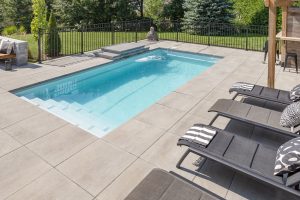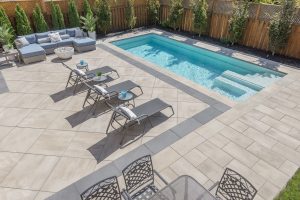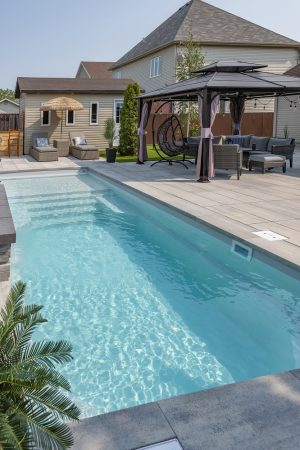What are the costs to consider when installing an inground fiberglass pool?
Installing an inground pool is a dream for many homeowners. If this is your next project to enjoy the outdoors during the summer season, be sure to also factor in the other associated costs.
In addition to the initial cost of the pool and its installation fees, there are several other aspects to consider. We have grouped them into 7 categories so that you can be fully prepared for this beautiful project.
Costs to consider:
1. Fencing
2. Poolside landscaping
3. Landscape planting
4. Equipment (heat pump, filtration system)
5. Secondary building to store equipment
6. Furniture and additional landscaping
7. Annual expenses
1. Choosing and installing a fence
Safety is the top priority to consider when adding an inground pool. In Quebec, all pools, including above-ground ones, must now be surrounded by a fence to prevent the risks of drowning. This protection is aimed at both unsupervised children and animals.
The enclosure must comply with regulations, including being a minimum height of 1.2 meters and having a secure locked gate. The Ministry of Municipal Affairs and Housing provides an evaluation form so you can assess the compliance of your fence installation.

1224 model – Arctic Grey
How much does a fence cost?
The price of a fence varies greatly depending on the selected material. It can cost anywhere from $14 to $120 per linear foot, depending on the material such as aluminum, PVC, chain link, and wood.
Even if you already have a nice, well-grown cedar hedge, you will still need to add a fence. If you want to maintain an aesthetic and harmonious look, shop for a fence that can blend with the surrounding vegetation.
Also, consider the maintenance of your cedars afterwards. Your access will be more limited, so careful consideration is necessary.
Tip for saving money
If you want to save money, consider fencing only the area dedicated to the pool. This will significantly reduce the number of required linear feet. However, this might create a visual barrier and decrease the aesthetic and harmonious aspect of your backyard, unless you choose tempered glass panels or an aluminum railing.
2. Backyard Design: Interlocking Paver models
In addition to the fence, you will need to add a walkway around the inground fiberglass pool. The width of the walkway must adhere to your municipality’s regulations.
There are mainly two options: concrete and interlocking pavers. For a more aesthetic and durable effect, opt for a pool border in interlocking pavers specially designed for this purpose.
Remember that to set up your new pool, excavation is necessary. Your land will need to be leveled again, and you can take this opportunity to decide how you want it to be landscaped.
It is highly recommended to create a detailed plan of your backyard with the addition of the pool and the planned landscaping before starting the work. The installation of Proma interlocking pavers, along with the finishing borders for the pool, can be done simultaneously with the rest of the work. This way, you will enjoy your new outdoor living space more quickly.

Lounge model – Sea Salt & Proma Quadra – Oka Beige by Rinox
3. Backyard Landscaping Finishing
To stay within your budget, consider postponing the rest of the landscaping work to the following year. As mentioned, the mandatory work upon installation includes the walkway surrounding the pool and the fence to secure the swimming area.
Since the purchase of an inground pool already represents a large investment, any additions of plants, trees, shrubs, as well as expanding the area of interlocking pavers, can be done the following year. This will spread the investment of your backyard over two seperate times.
Another option is to finance the entire backyard project. This will allow you to complete the entire project at one time while spreading the payments overall several months, requiring little to no upfront payment.
4. Additional Equipment: Heat Pump, Electricity, Filtration, and Cover
Many pool owners (inground or not) wish to swim in well-tempered water. Plan for the purchase of a suitable heat pump. A certified electrician must be called upon to handle the required electrical installation. If not for the heat pump, for the filtration and water treatment system using chlorine or salt.
You can also choose to buy a solar cover to help the water reach a pleasant temperature. Inground pools have much less temperature variation than their above-ground counterparts, which is one of the great advantages of this type of installation.
5. Equipment Storage Building for Your New Pool

1025 beach model – Arctic Grey
Why build a storage building? On one hand, for aesthetic reasons, and on the other, for practicality and the lifespan of your pool equipment and accessories. It will also serve to store your maintenance and cleaning equipment, as well as the salt or chlorine, depending on the chosen system.
When designing your plan, add the desired location of this small building so that it’s easily accessible while maintaining a safe space between the pool edge and access to the yard.
If you already have a shed, its location is optimal, and it has the necessary space to accommodate the equipment, consider having the pool installed based on that. Be sure to comply with all requirements set by the municipality.
6. Relaxation: Furniture, Gazebo, Outdoor Kitchen
Certainly, this section is likely one of the favorites. However, costs add up quickly. Both the furniture and the addition of a gazebo or outdoor kitchen space can individually cost a few thousand dollars.
Need some inspiration? We’ve got you covered with our section full of unique ideas, projects, and collaborations.
Which Pool to Choose? Do You Need Financing?
If you prefer to complete everything in the same year, consider financing using a home equity line of credit. This type of financing has a rate very similar to that of a mortgage, and the maximum amount is assessed based on the available equity in your home.
This equity is the difference between the market value of your property and the current amount of your mortgage, up to 80% of its total value.
Example
(Market value of $500,000 x 80% = $400,000) – mortgage of $300,000
Total potential financing of $100,000
Annual Expenses to Add to the Purchase Price, Regardless of Pool Size
When you decide to have a new pool installed, whether in-ground or above-ground, regardless of the model, it comes with annual expenses:
There’s electricity for heating and filtration.
Home insurance increases.
The purchase of chlorine or salt for water treatment.
Opening and closing fees that you can entrust to a specialist.
Regulations for Installing a Pool
Even before shopping for an in-ground pool, start by inquiring about your municipality’s regulations. Not only do you need to respect minimum setback distances from property lines, but you also need to adhere to maximum allowable size.
Each municipality is responsible for setting certain standards. You always have limitations on the dimensions of secondary buildings (garages and sheds), as well as the area that each element can occupy.
For instance, if your inground pool cannot exceed more than 30% of the total area of the lot, sit down and calculate the dimensions to adhere to when selecting your pool.
Need a quote? Let’s talk about your project!










